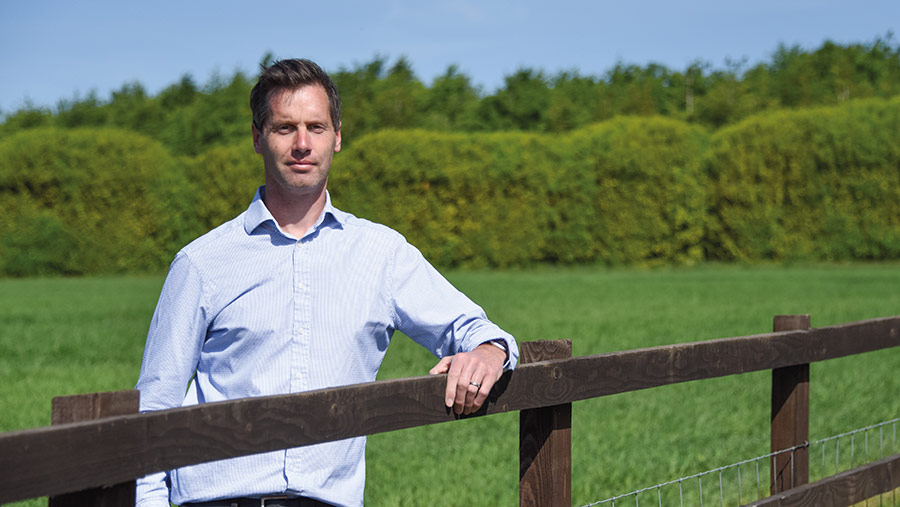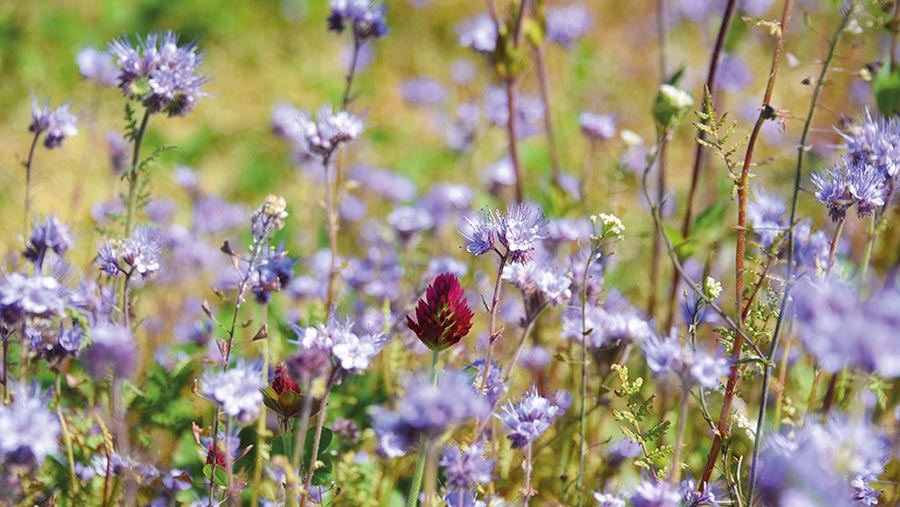How stewardship is helping estate to form future plans
 Nick Down © Velcourt
Nick Down © Velcourt Using Countryside Stewardship to take 305ha out of arable production is allowing Yattendon Estate in Berkshire to focus on its core farming activities, deliver for the environment and prepare for the future.
Velcourt farm manager Nick Down points out that by using as many as 12 different scheme options he has been able to take out less productive areas and awkward corners, while running the 3,200ha business with one main set of machinery and retaining the estate’s heritage.
See also: How Hampshire grower became Soil Farmer of the Year
Farm facts: Yattendon Estate
- Total area 3,600ha (including tenanted farms)
- Estate farm 2,150 ha
- Woodland 883ha
- Christmas trees 142ha
- Countryside Stewardship 305ha
- Rare breed British White cattle on parkland
- Partnerships with neighbours for livestock integration
Stewardship has also helped him to widen the rotation, focus on soil health, and develop a more integrated farming system, with a partnership with a neighbouring farm providing the mob grazing required since the introduction of legume and herb-rich leys.
Bird counts, butterfly surveys and other ecological monitoring is being carried out, so that Mr Down can understand more about what’s working well, use the data to help with future decision-making, and get the estate’s natural capital providing the public goods expected by policymakers.
“We are aware of some of what Defra is going to ask from us in the future and we are also taking part in the Sustainable Farming Incentive Pilot, so that we are ready to move forward when the time is right,” he says.
Public engagement
Having been part of the Leaf/Corteva Ready and Resilient programme for the past three years, the estate has recently launched as a Leaf demonstration farm and he is looking forward to the public engagement that will entail.
“This is a large estate which has quite an impact on the local community,” says Mr Down. “We have 84km of footpaths across the land and have found that two-way information flow is key – farming is in the news at the moment and people want to know more about what we are doing.”
A regular participant in Open Farm Sunday and a host site for school days, he is happy to do more. “As an industry, farming is facing some enormous challenges and we need to make sure that we are tackling them and explaining how we are doing that.”

© Velcourt
Stewardship agreement
In terms of the Mid-Tier stewardship agreement, he has gone for cover crops, legume and herb-rich leys, two-year legume-based fallows, flower-rich and grass margins, wild bird food plots, low-input grassland and various other measures – with a mix of rotational and permanent options, all designed to support and build biodiversity.
He has also given a 3ha corner over to rewilding, to see what happens to the area and how it contributes to wildlife over time.
To complement these measures, the farm has minimised the use of insecticides and is looking for ways to reduce other inputs, as well as increasing soil organic matter levels and monitoring its greenhouse gas emissions.
Soil health
Mr Down oversees 1,650ha of combinable crops, with the area all going through one combine. The estate’s very varied soils – which reflect its geographical spread from the Thames basin to rolling downland – demand a range of establishment methods.
“We have easy working chalk soils, drought-prone light, sandy soils and abrasive clay and flint soils,” he reports. “Having previously run an intensive min-till system, we are now moving to direct drilling where appropriate and low disturbance, shallow cultivations if required.”
The soils are changing with the addition of organic matter in the form of chopped straw, 1,000t of farmyard manure and rotational use of digestate and biosolids. Some 12 fields are being monitored by in-depth soil analysis of physical, chemical and biological properties, with the intention to build the resilience that soils need to cope with weather extremes.
Cropping
Wheat is grown for milling and aimed at local mills within 100 miles of the farm. Nitrogen use, now at 270-280kg/ha of N to hit specification, is under review, with inhibitor products being assessed.
Oilseed rape is back in the rotation after a three-year break, taking the place of linseed, and is being grown with early nutrition and minimal inputs on a one in six-to-seven-year basis.
Hybrid winter barley also has a place, so that he can use its early entry contribution for following crops. “The downside with that is grass weed control, so we have to place it strategically.”
Otherwise, there is 300ha of spring barley – most of which is following cover crops – as well as winter and spring beans, peas and some spring oats. The winter beans are direct drilled into a catch crop established after the barley harvest, which has worked well.
Livestock
Sheep are used to graze multi-species cover crops, which helps to deal with big amounts of biomass, but can cause issues if it is wet. “I’m still deciding whether they are a help or a hindrance. In wet conditions, they can undo much of the good.
“The timing restrictions under CS also reduce our flexibility and we’re pushed into grazing later than we’d like in conditions that are counterproductive,” he says.
Stewardship at Yattendon Estate |
|
| Option | Area (ha) |
| AB1 Nectar flower plots | 45 |
| AB5 Ground nesting bird areas | 3 |
| AB8 Flower-rich margins and plots | 37 |
| AB9 Wild bird seed mix plots | 26 |
| AB15 Two-year legume sown fallows | 121 |
| AB16 Autumn bumblebird plots | 24 |
| SW1 6m grass margins and strips | 7 |
| SW6 Winter cover crops | 200 |
| GS2 Low input grassland | 40 |
| GS4 Legume and herb-rich grass | 42 |
| Supplementary winter feeding | 4 (tonnes) |
Carbon footprint
Yattendon Estate’s carbon footprint has been measured for the past three years using the Farm Carbon Toolkit – chosen for its whole farm approach.
With more than 800ha of woodland, the business is in a good position and Nick Down likes the fact that he can measure and monitor the emissions arising from farming activities, as well as any sequestration. At this point, it’s only a guide, but it does highlight the areas of the business where changes could be made.
He is in no hurry to trade carbon credits and is using his time to learn more about carbon, rather than sell it.
In 2021, the business produced emissions of 3,189.51t of carbon dioxide equivalents and offset 2,790.07t of carbon dioxide equivalents, leaving a balance of 399.44t carbon dioxide equivalents.
Landscape recovery
Yattendon Estate is one of 10 members of a landscape recovery group which is looking at how it can deliver for the environment and biodiversity on a larger scale within their area.
Farmers working together can drive change, believes Nick Down, who points out that the self-financing group is based in the Thames Water catchment along the River Pang.
Soil, water and wildlife could benefit from the collective delivery that such a group provides, he adds.

